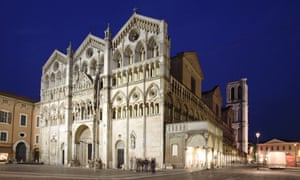Most Italian convents were disbanded after Napoleon invaded but among the glories of Ferrara two working ones still exist, both of them rich in history. Corpus Domini is famous both for its visionary 15th-century nun and for the tomb of the infamous Lucrezia Borgia, who married into the Ferrarese royal family in 1502 and produced a crop of heirs.
The other, Sant'Antonio in Polesine, on which I based my novel Sacred Hearts, is even more special. Originally a thriving Benedictine convent for noblewomen, it now sits serene and secluded at the edge of the city wall, home to just 17 elderly nuns.
Like the nuns of Corpus Domini they are enclosed, but if you visit between certain hours and ring the bell, a sister will talk to you through the grille, then crack open the door and guide you to the inner chapel, the walls of which are filled with wonderful, delicate frescoes from the time of Giotto.
Later you can sit in the outer church and listen while those 17 nuns sing public vespers on the other side of the altar grille. Their ageing voices are cracked and desperately sad compared with the great choir that would have enthralled the city's dignitaries 500 years ago, but like so much in Ferrara, the experience is a reminder of the unexpected delights that this jewel of a city has to offer the more intrepid tourist.
Essentials
Ryanair (
ryanair.com) flies from Edinburgh, Birmingham and Stansted to Bologna, 35 miles from Ferrara. Suite Duomo (00 39 0532 793888;
suiteduomo.it) has doubles from €80. The Monastero di San Antonio in Polesine (
leabbazie.it/emilia_romagna/ferrara) is open from 3.15pm-5pm on weekdays. The Monastero di Corpus Domini is currently closed for restoration but check the website above for opening hours. Further tourist information from
ferraraterraeacqua.it.



























